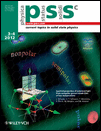Investigation of inversion domain formation in AlN grown on sapphire by MOVPE
Abstract
For certain growth conditions pronounced roughening has been observed for AlN layers grown on c-plane sapphire by metal-organic vapour phase epitaxy. TEM investigations revealed inversion domains correlated with the rough regions of the wafer. Al-polar material was found at hillocks and N-polar AlN in the valleys. We have investigated the early stages of growth and found three determining factors for the polarity development in AlN on c-plane sapphire: substrate treatment by NH3 (nitridation) or TMAl preflow, substrate treatment by annealing under H2 atmosphere and the influence of parasitic depositions in the reactor. We propose a correlation between the sapphire surface termination and the polarity of AlN. Oxygen termination of sapphire is suggested to lead to N-polarity and aluminium termination to Al-polar AlN. By optimising the reactor condition, substrate treatment and growth conditions, smooth Al-polar AlN layers were obtained for the subsequent growth of deep UV-LED heterostructures. (© 2012 WILEY-VCH Verlag GmbH & Co. KGaA, Weinheim)




